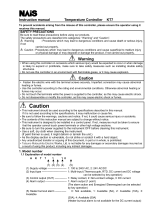
3
Caution with respect to Export Trade Control Ordinance
To avoid this instrument from being used as a component in, or as being utilized in the manufacture of
weapons of mass destruction (i.e. military applications, military equipment, etc.), please investigate the
end users and the final use of this instrument.
In the case of resale, ensure that this instrument is not illegally exported.
1
1
.
.
I
I
n
n
s
s
t
t
a
a
l
l
l
l
a
a
t
t
i
i
o
o
n
n
P
P
r
r
e
e
c
c
a
a
u
u
t
t
i
i
o
o
n
n
s
s
Caution
This instrument is intended to be used under the following environmental conditions (IEC61010-1):
Overvoltage category , Pollution degree 2
Ensure the mounting location corresponds to the following conditions:
• A minimum of dust, and an absence of corrosive gases
• No flammable, explosive gases
• No mechanical vibrations or shocks
• No exposure to direct sunlight, an ambient temperature of 0 to 50 (32 to 122 ) that does not
change rapidly, and no icing
• An ambient non-condensing humidity of 35 to 85 %RH
• No large capacity electromagnetic switches or cables through which large current is flowing
• No water, oil or chemicals or the vapors of these substances can come into direct contact with
the unit
• Please note that the ambient temperature of this unit – not the ambient temperature of the control
panel – must not exceed 50 (122 ) if mounted through the face of a control panel, otherwise the
life of electronic components (especially electrolytic capacitors) may be shortened.
Note: Avoid setting this instrument directly on or near flammable material even though the case
of this instrument is made of flame-resistant resin.
2
2
.
.
W
W
i
i
r
r
i
i
n
n
g
g
P
P
r
r
e
e
c
c
a
a
u
u
t
t
i
i
o
o
n
n
s
s
Caution
• Do not leave wire remnants in the instrument, as they could cause a fire or malfunction.
• Use the solderless terminal with an insulation sleeve in which the M3 screw fits when wiring the
instrument.
• Tighten the terminal screw using the specified torque. If excessive force is applied to the screw
when tightening, the terminal screw or case may be damaged.
• This controller does not have a built-in power switch, circuit breaker and fuse. It is necessary to
install a power switch, circuit breaker and fuse near the controller.
(Recommended fuse: Time-lag fuse, rated voltage 250 V AC, rated current 2 A)
• For a 24 V AC/DC power source, do not confuse polarity when using direct current (DC).
• Do not apply a commercial power source to the sensor which is connected to the input terminal
nor allow the power source to come into contact with the sensor.
• Use a thermocouple and compensating lead wire according to the sensor input specifications of
this controller.
• Use the 3-wire RTD according to the sensor input specifications of this controller.
• When using a relay contact output type, externally use a relay according to the capacity of the
load to protect the built-in relay contact.
• When wiring, keep input wires (thermocouple, RTD, etc.) away from controller AC power sources
or load wires.
3
3
.
.
O
O
p
p
e
e
r
r
a
a
t
t
i
i
o
o
n
n
a
a
n
n
d
d
M
M
a
a
i
i
n
n
t
t
e
e
n
n
a
a
n
n
c
c
e
e
P
P
r
r
e
e
c
c
a
a
u
u
t
t
i
i
o
o
n
n
s
s
Caution
• It is recommended that the AT be performed on the trial run.
• Do not touch live terminals. This may cause electric shock or problems in operation.
• Turn the power supply to the instrument OFF before retightening the terminal or cleaning.
Working on or touching the terminal with the power switched ON may result in severe injury or
death due to electrical shock.
• Use a soft, dry cloth when cleaning the instrument.
(Alcohol based substances may tarnish or deface the unit.)
• As the display section is vulnerable, be careful not to put pressure on, scratch or strike it with
a hard object.




















